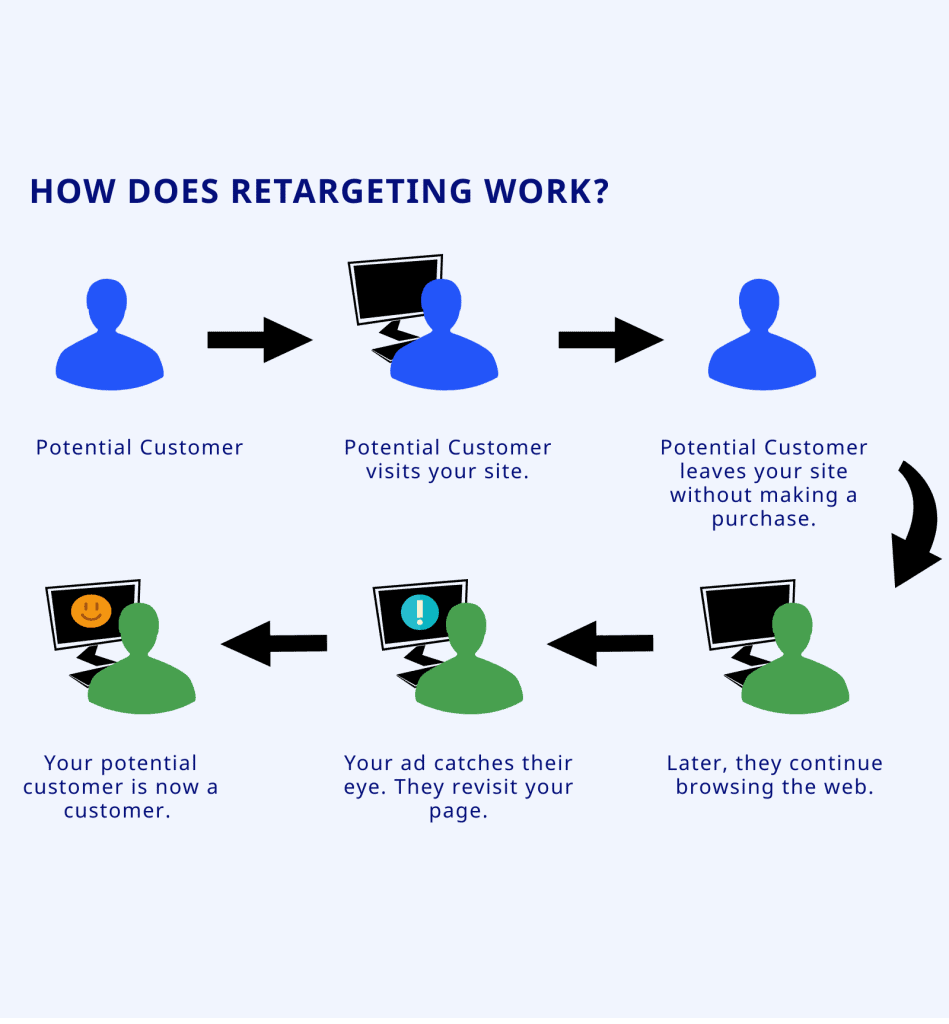According to a 2016 BI Intelligence report, 97% of first-time visitors to your website will leave without buying anything.
That’s a staggering amount of lost prospects. How do you get them back?
The answer is this, you do it by retargeting.
What is retargeting? Retargeting is a form of advertising that targets visitors who have previously visited your site. If you’re interested in keeping more of that 97 % of visitors – and let’s face it, who isn’t – then this article is for you.
How Does Retargeting Work?
Imagine this: a potential customer visits your site for the first time.
- The visitor cruises around for a few minutes — maybe they even put an item in their cart. But before they hit that checkout button, they get distracted, and poof: they’ve disappeared into the ether of the Internet.
- However, not all is lost. Because you’ve set up retargeting ads, this potential customer begins to see your ads as they browse the web.
- The ads might show up in articles they read or videos they watch. Now that they recognize your brand from their previous browsing session, you’ve piqued their interest.
- Shortly thereafter, they return to your website and complete a purchase.
Easy, right? Retargeting seems simple enough, but the nitty-gritty of driving traffic to your site with retargeted ads is a bit more complex.
Types of Retargeting
Retargeting usually works in one of two ways: pixel retargeting or list-based retargeting.
Pixel Retargeting:
Pixel retargeting is probably the most common method used. It involves leaving a cookie on a visitor’s browser that directs retargeting platforms to show specific ads based on what page they visited on your website.
There are a few steps to pixel retargeting, and they vary depending on your platform. However, regardless of your platform, you’ll need to add a retargeting script from Google, Facebook, or whatever platform you choose to your website. Here is an example:
<script type=”text/javascript”>
(function() {
window._pa = window._pa || {};
// _pa.orderId = “myOrderId”; // OPTIONAL: attach unique conversion identifier to conversions
// _pa.revenue = “19.99”; // OPTIONAL: attach dynamic purchase values to conversions
// _pa.productId = “myProductId”; // OPTIONAL: Include product ID for use with dynamic ads
var pa = document.createElement(‘script’); pa.type = ‘text/javascript’; pa.async = true;
pa.src = (‘https:’ == document.location.protocol ? ‘https:’ : ‘http:’) + “//tag.marinsm.com/serve/abc123.js”;
var s = document.getElementsByTagName(‘script’)[0]; s.parentNode.insertBefore(pa, s);
})();
</script>
You may want to attach a retargeting code to a short URL (to improve user experience). No one likes a messy, long URL. For this process, you’ll need a URL shortener that supports this feature. We recommend Terminusapp’s URL Shortener. It will make the shortening process simple and easy for you so you can focus your efforts on your campaign.
List-Based Retargeting:
List-based retargeting works when you have your target customers’ contact information in your database. Your retargeting platform will retarget ads specifically to the email addresses you’ve provided, usually on a social media platform the email is associated with, like Twitter or Facebook. This method allows you to be highly specific with your retargeting, as you’re able to choose which contacts will see which ads.
Now that you have a good idea of what retargeting is and how it works, let’s dive into what kinds of retargeting campaigns will help you reach your goals, and why retargeting is so effective.
Retargeting Goals: Brand Awareness and Conversion
There are two main types of retargeting campaigns: awareness and conversion. Each serves a specific purpose for your advertising goals.
Awareness Campaigns:
These campaigns are typically driven by pixel-based retargeting. They’re useful for engaging previous site visitors and letting them know about certain promotions, features, sales, or other relevant messages. The goal here is to make prospects increasingly aware of your brand, so while awareness campaigns don’t always yield impressive click-through rates, they’ll set the foundation for going one step further in the retargeting process: conversion.
Conversion Campaigns:
Your goal with these campaigns is to get people to click on your ad and complete the next logical step in the sales funnel. That could mean completing a purchase or filling in a form with their contact information — it all depends on which part of the funnel you want to direct your consumers.
Why Is Retargeting Effective?
A 2015 AdRoll study found that over 90% of marketers reported that retargeting performed as well as or better than ads in search engines, emails, and other mediums. What’s more, AdRoll also reported that retargeting drives measurable ROI across social media channels and mobile devices.
There are a two primary reasons for why retargeting ads are so effective:
Personalization
For starters, retargeted ads are personalized. They allow you to effectively target your audience based on their demonstrated preferences and behavior.
Customizing your retargeting response based on the actions of a visitor, user, or customer means you’re able to reach more quality prospects. In fact, 25% of surveyed online viewers actually enjoyed seeing retargeted ads because they were reminded of products and services they were previously considering.
Brand Awareness
Retargeting keeps your brand fresh in your prospects’ minds, giving them a gentle reminder of all the amazing products or services you have to offer.
Every time a customer sees your retargeted ads, they establish an idea and a memory of your brand. AdRoll sums it up pretty nicely: “The high click-through rates and increased conversions that are typical with retargeting campaigns underscore the value of good branding and repeated exposure.” According to Criteo, website visitors who see retargeted advertisements are more likely to convert by 43%.
Retargeting Best Practices
By now, you’re probably ready to get started with retargeting advertisements and increase your conversions. But before you fire away in your retargeting platform, make sure to keep these best practices in mind. You want to be confident that you’re putting out optimized advertisements that will capture attention and drive customers to your site.
A well-made, optimized retargeting ad consists of the following:
- An eye-catching headline.
Grab your customers’ attention with a short, sweet, compelling headline. It should be relevant to the visitors’ experience on your website.
- Visually appealing media.
Whether that’s a still image, a video, or maybe even a GIF, make sure the media in your ad is relevant and engaging.
- Sharp and action-oriented copy.
Like your headline, the body copy should be concise, punchy, and attention-grabbing. Readers are more likely to click on your ad if the copy is brief and compelling.
- An inviting CTA button.
This should include contrasting colors — the button’s design should invite readers to click on it — and a compelling call to action (for example, “Sign Up For Free.”)
Wrapping it Up
Retargeting is one of the most effective marketing techniques for recapturing your site visitors’ interest and turning them into paying customers. Displaying relevant advertisements for your website visitors not only heightens your own brand awareness, but effectively creates a personalized ad experience for your prospects, which will help increase your conversions. Retargeting ads perform just as well as, if not better than, other forms of digital advertisements, generating high ROI and conversion rates. By displaying optimized retargeted ads embellished with punchy copy and results-oriented graphics to match, you’ll be running a marketing campaign that packs a punch in no time.





